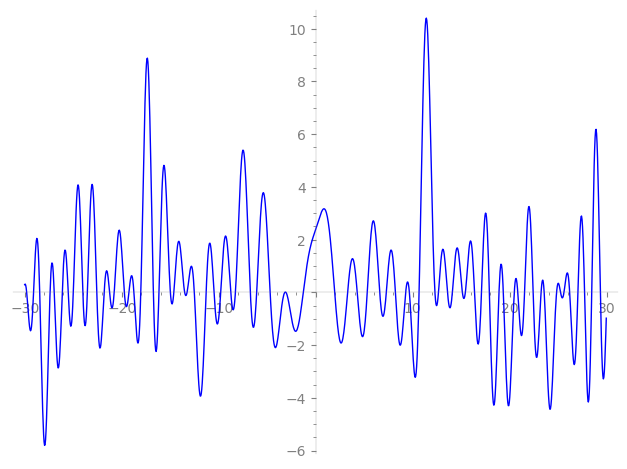| L(s) = 1 | + (0.5 − 0.866i)2-s + (1.72 − 0.194i)3-s + (−0.499 − 0.866i)4-s + (0.866 + 0.5i)5-s + (0.691 − 1.58i)6-s − 1.96·7-s − 0.999·8-s + (2.92 − 0.670i)9-s + (0.866 − 0.499i)10-s − 4.91i·11-s + (−1.02 − 1.39i)12-s + (1.73 − 1.00i)13-s + (−0.980 + 1.69i)14-s + (1.58 + 0.691i)15-s + (−0.5 + 0.866i)16-s + (3.39 + 1.96i)17-s + ⋯ |
| L(s) = 1 | + (0.353 − 0.612i)2-s + (0.993 − 0.112i)3-s + (−0.249 − 0.433i)4-s + (0.387 + 0.223i)5-s + (0.282 − 0.648i)6-s − 0.741·7-s − 0.353·8-s + (0.974 − 0.223i)9-s + (0.273 − 0.158i)10-s − 1.48i·11-s + (−0.297 − 0.402i)12-s + (0.481 − 0.278i)13-s + (−0.261 + 0.453i)14-s + (0.409 + 0.178i)15-s + (−0.125 + 0.216i)16-s + (0.823 + 0.475i)17-s + ⋯ |
\[\begin{aligned}\Lambda(s)=\mathstrut & 570 ^{s/2} \, \Gamma_{\C}(s) \, L(s)\cr =\mathstrut & (0.251 + 0.967i)\, \overline{\Lambda}(2-s) \end{aligned}\]
\[\begin{aligned}\Lambda(s)=\mathstrut & 570 ^{s/2} \, \Gamma_{\C}(s+1/2) \, L(s)\cr =\mathstrut & (0.251 + 0.967i)\, \overline{\Lambda}(1-s) \end{aligned}\]
Particular Values
| \(L(1)\) |
\(\approx\) |
\(1.89398 - 1.46405i\) |
| \(L(\frac12)\) |
\(\approx\) |
\(1.89398 - 1.46405i\) |
| \(L(\frac{3}{2})\) |
|
not available |
| \(L(1)\) |
|
not available |
\(L(s) = \displaystyle \prod_{p} F_p(p^{-s})^{-1} \)
| $p$ | $F_p(T)$ |
|---|
| bad | 2 | \( 1 + (-0.5 + 0.866i)T \) |
| 3 | \( 1 + (-1.72 + 0.194i)T \) |
| 5 | \( 1 + (-0.866 - 0.5i)T \) |
| 19 | \( 1 + (3.86 + 2.01i)T \) |
| good | 7 | \( 1 + 1.96T + 7T^{2} \) |
| 11 | \( 1 + 4.91iT - 11T^{2} \) |
| 13 | \( 1 + (-1.73 + 1.00i)T + (6.5 - 11.2i)T^{2} \) |
| 17 | \( 1 + (-3.39 - 1.96i)T + (8.5 + 14.7i)T^{2} \) |
| 23 | \( 1 + (-5.91 + 3.41i)T + (11.5 - 19.9i)T^{2} \) |
| 29 | \( 1 + (-2.51 - 4.35i)T + (-14.5 + 25.1i)T^{2} \) |
| 31 | \( 1 - 0.233iT - 31T^{2} \) |
| 37 | \( 1 - 7.19iT - 37T^{2} \) |
| 41 | \( 1 + (5.88 - 10.1i)T + (-20.5 - 35.5i)T^{2} \) |
| 43 | \( 1 + (2.94 - 5.10i)T + (-21.5 - 37.2i)T^{2} \) |
| 47 | \( 1 + (1.60 - 0.929i)T + (23.5 - 40.7i)T^{2} \) |
| 53 | \( 1 + (5.29 + 9.16i)T + (-26.5 + 45.8i)T^{2} \) |
| 59 | \( 1 + (4.25 - 7.37i)T + (-29.5 - 51.0i)T^{2} \) |
| 61 | \( 1 + (-3.91 - 6.77i)T + (-30.5 + 52.8i)T^{2} \) |
| 67 | \( 1 + (13.7 - 7.93i)T + (33.5 - 58.0i)T^{2} \) |
| 71 | \( 1 + (-2.26 + 3.92i)T + (-35.5 - 61.4i)T^{2} \) |
| 73 | \( 1 + (-1.13 + 1.97i)T + (-36.5 - 63.2i)T^{2} \) |
| 79 | \( 1 + (-10.7 - 6.22i)T + (39.5 + 68.4i)T^{2} \) |
| 83 | \( 1 + 13.7iT - 83T^{2} \) |
| 89 | \( 1 + (5.48 + 9.49i)T + (-44.5 + 77.0i)T^{2} \) |
| 97 | \( 1 + (13.3 + 7.68i)T + (48.5 + 84.0i)T^{2} \) |
| show more | |
| show less | |
\(L(s) = \displaystyle\prod_p \ \prod_{j=1}^{2} (1 - \alpha_{j,p}\, p^{-s})^{-1}\)
Imaginary part of the first few zeros on the critical line
−10.48432891438316160552150281548, −9.795618295142188682775853901455, −8.756244363062249662662293884446, −8.279687265791309722211192916969, −6.74299150676895006628615755377, −6.08619789123531629885313898146, −4.70007793294961375393464656832, −3.18266083862641716603188518212, −3.07476894899707741606139710489, −1.28344952641066381348845899935,
1.95499568150997337099322736902, 3.28958944861741259225041530637, 4.27666864313901294270296957542, 5.31099464798766548952670635585, 6.59584587891475136459850231820, 7.27697530419327362297345076270, 8.212069061155733467998512213007, 9.272734035058760861874831950192, 9.653205440282966023035250124651, 10.65305060659991713606939263166

